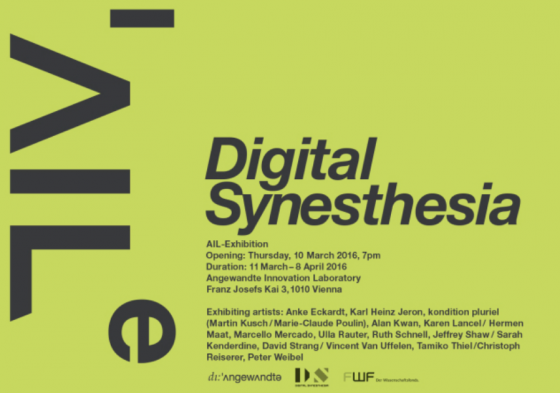DIGITAL SYNESTHESIA Exhibition Opening at Angewandte Innovation Laboratory (AIL) in Vienna
 Exhibition Opening: March 10, 2016, 7.00 p.m.
Exhibition Opening: March 10, 2016, 7.00 p.m.
The DIGITAL SYNESTHESIA project (2013 – 2016) is a transdisciplinary artistic research area which explores the (syn-)aesthetics of digital art. It especially focuses on its technological, aesthetic and media conditions which make it possible to provide synesthetic experiences for individuals.
The aesthetic results of the artistic research project DIGITAL SYNESTHESIA will be presented to the public in an exhibition with 13 digital artworks at the Angewandte Innovation Laboratory from March 11 to April 8, 2016.
The show will exhibit interactive installations, responsive environments, performances and their representations, live sonifications and immersive installations by DIGITAL SYNESTHESIA artists Anke Eckardt, Karl-Heinz Jeron, kondition pluriel, Alan Kwan, Karen Lancel/Hermen Maat, Marcello Mercado, Ulla Rauter, Ruth Schnell, Jeffrey Shaw/Sarah Kenderdine, David Strang/Vincent Van Uffelen, Tamiko Thiel/Christoph Reiserer and Peter Weibel.
 SYNESTHETIC DIGITALISM - AN ARTISTIC FIELD OF RESEARCH
SYNESTHETIC DIGITALISM - AN ARTISTIC FIELD OF RESEARCH
The Digital Synesthesia project expands upon the scientific spectrum of synesthesia research by introducing the possibilities of digital technologies as artistic research medium. Science has implemented specially targeted stimuli that the sensory organs and the human brain process into impressions and in so doing looks for answers in memory research and sensory research. Artists have contributed to an artistic evolution — that through digital art in the field of experimental sensory art — besides their epistemological and aesthetic potential also point towards the ever-accelerated technological developments.
EXPERIMENTAL FIELD BETWEEN ART AND RESEARCH
The objective of the research project is to provide an experimentation platform for the
portrayal of synesthetic mechanisms while perceiving digital artwork. This experimentation platform is designed in such a way that the observation of the project processes and the scientist are also a part of the research process. The observation process is implemented with the help of communicative and aesthetic feedback control loops in the form of a project website, two trans-disciplinary workshops, research interviews as well as an interdisciplinary symposium and ultimately reflected in exhibitions in Vienna (March 2016) and Hong Kong (May 2016).
COOPERATION BETWEEN ARTS AND SCIENCE
The artists study the synesthetic moment through the perception of digital artwork taking into account the most up to date knowledge in the neurosciences and cognitive sciences. In so doing, they open up new pathways into the field of synesthesia research. Their studies are presented in the form of fifteen digital artworks.
With the introduction of the term digital synesthesia into digital art the influence of algorithmic-synesthetic phenomena on our digitalized culture becomes clearly tangible. Today’s connected digital data world can be defined, per se, as synesthetic culture.
Project leaders
Univ. Prof. Mag. art Ruth Schnell, Dr. Katharina Gsöllpointner, Dr. Romana Schuler
International cooperation partners
School of Creative Media at City University Hong Kong (Prof. Jeffrey Shaw),
ZKM Center of Art and Media Technologies Karlsruhe, D (Prof. Peter Weibel)
Participating artists
Anke Eckardt (D), Tina Frank (A), Karl-Heinz Jeron (D), Karen Lancel/Hermen Maat (NL ), Martin Kusch/Marie-Claude Poulin (kondition pluriel, CAN /A), Alan Kwan (CHN /USA),
Marcello Mercado (ARG/D), Ulla Rauter (A), Ruth Schnell (A), Jeffrey Shaw (AUS/CHN ),
David Strang/Vincent Van Uffelen (UK), Tamiko Thiel/Christoph Reiserer (USA/D),
Peter Weibel (A/D)
Participating scientists/scholars
Katharina Gsöllpointner (University of Applied Arts Vienna), Lawrence Marks (The John B. Pierce Laboratory/Yale University), Aleksandra Mroczko-Wasowicz (Institute of Philosophy of Mind and Cognition, National Yang Ming University, Taiwan), Danko Nikolic (Department of Neurophysiology at Max Planck Institut for Brain Research, Frankfurt Institute for Advanced Studies), Romana Schuler (University of Applied Arts Vienna), N.N.
Publication
DIGITAL SYNESTHESIA . A Model for the Aesthetics of Digital Art. (Eds. Katharina
Gsöllpointner, Ruth Schnell, Romana Schuler. Edition Angewandte. Berlin/Boston:
De Gruyter) will be published in spring 2016 and collects the findings and results of
the project. It represents, for the first time, a comprehensive compendium of this
new concept of digital art in the 21st century.